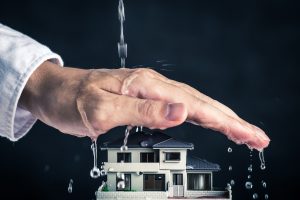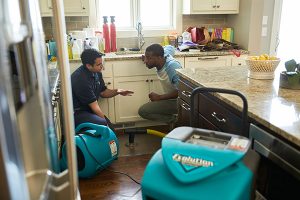
The promise of warm spring weather and brighter days brings with it the risks associated with spring thaws. Winter snow that melts in the spring has the potential to run off toward your home, causing significant flooding. In fact, it takes just a few inches of water to cause tens of thousands of dollars in structural damage. It is important to protect your home against spring flood damage well before the spring thaw.
What Causes Spring Flood Damage?
Each compacted foot of snow is made up of gallons of water. The arrival of warm weather melts any remnants of snow quickly, producing large amounts of runoff within a brief period of time. When pooled water sits near your home’s foundation, water damage is a likely outcome.
Combine spring thaws with heavy spring rains, and home flooding is a dangerous risk. Torrential spring downpours can bring with it several inches of water within the span of a few hours. At-risk areas are prone to flooding, especially when the ground is oversaturated. Plus, storm drains can overflow. River banks can also overspill as a result of heavy rains. Nearby structures are, as a result, at risk for water damage.
Dangers of Spring Flooding
Winter snow that melts in the spring has the potential to run off toward your home, causing significant flooding.
Properties built near flood zones or homes situated near high-risk areas are likely to sustain repeated water damage. Constant flooding has numerous repercussions. Frequent flooding damages the home’s foundation. Plus, disastrous flooding reduces the home’s property value. Homeowners who file frequent insurance claims for flooding will see a spike in their insurance premiums and deductibles. Mold growth is a major concern, too, as mold thrives in the dampened recesses of a home. Occupants who live in a dampened home are likely to experience respiratory issues.
Get Familiar with Your Insurance Policy
Whether or not you live in a flood-prone area, it is important to understand your homeowner’s insurance coverage. Flood insurance is not included in the average homeowner’s policy. Rather, flood insurance must be purchased separately. Most policies also do not cover water damage that results from spring thaw flooding or backed up sewers—unless you pay the higher premium specifically to add this type of coverage to your policy.
Prepare Your Home for Spring Flood Risks
While no home is completely safe from spring flooding, homeowners can take a few steps to prevent the damaging consequences of floods.
Indoors
Sump Pumps
Install a sump pump, or alternately, a sump pump that prevents sewer backflow. Ensure that the sump pump functions optimally. A battery-operated backup sump pump is ideal during power outages, which are common occurrences during torrential spring thunderstorms. Ensure that your sump pump’s discharge hose and downspout drain away from your home’s foundation.
Water Alarm
Install a water alarm in your basement. This convenient device warns homeowners when excess water accumulates in the basement.
Valuables
Shift valuable property out of the basement. As a preventive measure against the water damage caused by spring flooding, move electronics and other valuables prior to the onset of spring’s warmer weather.

Doors and Windows

Examine all doors and windows for leaks.
Examine all doors and windows for leaks. If you stumble upon a leak, take steps to seal them right away.
Foundation
Inspect your home’s foundation for any flaws. Water can easily seep inside when cracks are present. If you notice any cracks in the foundation, take immediate steps to seal or repair the cracks with epoxy putty or by hiring a contractor.
Outdoors
Snow
Shovel snow away from the perimeter around your home, paying particular attention to snow surrounding the foundation and window wells. March and April weather makes snowmelt likely, leading to possible water seepages into your basement.
Gutters
Clean your home’s gutters, downspouts and window wells. Remove any debris, including leaves, twigs and even snow, to ensure the gutter drains properly. Also make sure the downspouts drain away from your home’s foundation.
Exterior Walls
Well-sealed, painted exterior walls help to keep the elements out of your home. Caulk can be efficiently used to seal cracks along the wall or around joints, such as window frames, door frames and molding. If repainting your home, use a quality primer or sealer.
Roof
Water that trickles into your home through leaks in the roof may be caused by snow melt or heavy spring rains. As a homeowner, it’s important to regularly maintain your roof. Take steps to examine the roof for water leaks and repair any leaks immediately.
Trees
Prune any nearby trees to ensure broken branches do not unexpectedly fall upon your home’s roof during a spring storm.

Landscape

Lessen the complications associated with water damage by contacting a professional water damage restoration company.
Low-lying areas are especially prone to flash flooding, which occurs when tremendous amounts of rain catapult to the ground within the short span of six hours, causing rapid flooding. Proper drainage in low-lying areas can be achieved with landscape work.
When your home is inundated by water from a spring thaw or spring rainstorms, significant flood damage will occur. Porous materials inside your home, like drywall, wood and insulation, absorb water quickly, resulting in structural damage. Mold and mildew growth are major health hazards that also accompany water damage.
Lessen the complications associated with water damage by contacting a professional water damage restoration company immediately upon noticing the water in your home. ServiceMaster Kwik Restore offers comprehensive water damage restoration services to contain the spread of damage and restore the property to its pre-damaged condition.
ServiceMaster Kwik Restore’s trained technicians utilize advanced water extraction equipment and powerful dehumidifiers to thoroughly dry the property and any affected materials, such as furniture, flooring and structures. Structural damage to flooring and woodwork is repaired by our water damage restoration professionals, and we will also clean and sanitize the property to eliminate waterborne microbes. Anti-microbial applications are available to homeowners, as well.
The ServiceMaster Kwik Restore team is available 24 hours a day to take emergency calls. We reliably serve the northern Illinois and Southern Wisconsin communities.

